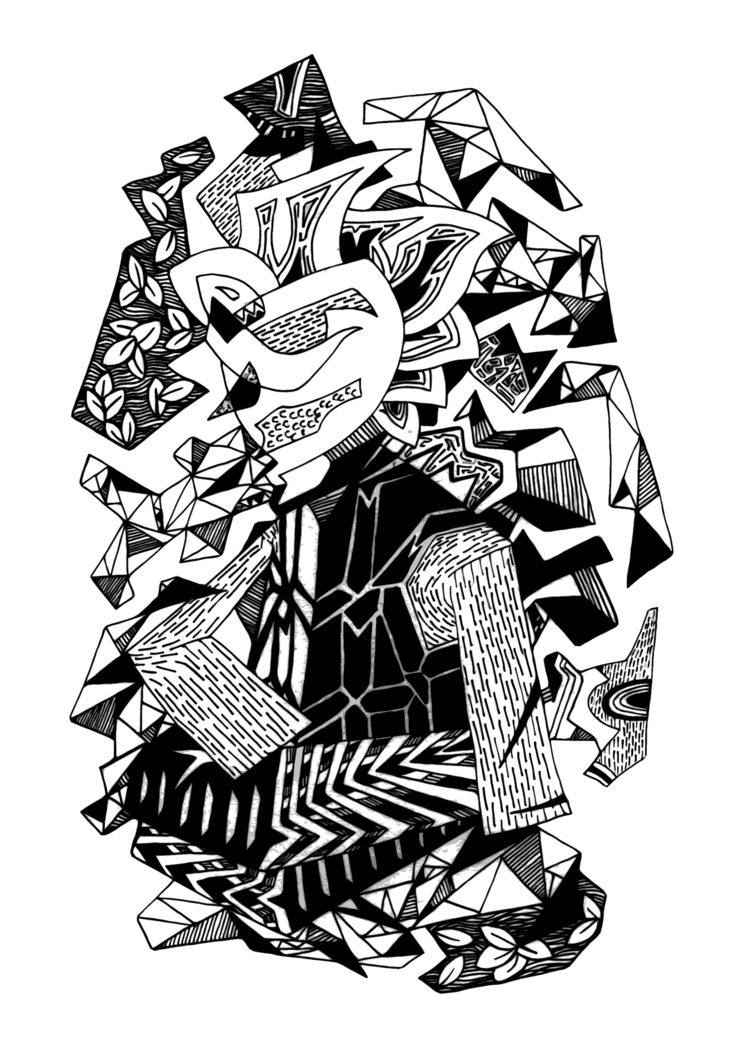farmer's field notes:
What is a Gmo?
In part one of a series, a farmer explains what GMOs are and what they mean for our relationship to the natural world.
//evan conklin
© 2015 Francois Pretorius, "(The Assembling of) Place In Thought"
If you’re like me, you try to eat some form of food at least three times a day. Despite being such an essential part of our lives, it seems like people have no idea what they should be eating. A good case in point is the current debate over Genetically Modified Organisms (GMO or GM foods). There is an attempt in a number of states to label GM foods, only one of which has been passed so far (Vermont). There’s also that Jimmy Kimmel segment where people have no clue what GMOs are but think they shouldn’t like them. Moreover, a lot of information out there says they’re the worst thing ever, and there’s a lot that tells us to take a chill pill and just eat what advertisers want you to eat.
I would posit that the general public needs more information about GMOs to make an informed opinion about them. This includes not only how GMOs affect the health of those who consume them but also their inextricable effects to the environment, the economy, and other facets of our lives. In my four years of working on various organic vegetable farms around the country, I’ve been able to understand some of these issues with a little more clarity. It’s not within the scope of this single essay to address the far reaching consequences of GMOs, but in order to properly interpret these consequences, we must start off with what they are scientifically, and what they expose about us as humans.
Put simply, a Genetically Modified (or Transgenic) Organism has had a section of DNA from a different organism inserted into its own genome to produce a desired effect. The most widely known example is Roundup Ready corn, which inserts the DNA of a Soil Bacterium into the corn genome to make corn resistant to the herbicide Roundup. The GMO debate mostly focuses on whether or not GM food crops (corn, soy, canola, wheat, etc.) are safe for human consumption because of the potentially negative effects of tampering with DNA.
Last summer Neil deGrasse Tyson, renowned physicist and patronizer, added his voice to the debate, explaining why he’s supportive of genetically engineered foods. His main argument is that Homo sapiens has been genetically engineering plants and animals since the dawn of agriculture by artificially selecting for seed size, sweetness, yield, etc. He points out that you don’t see wild versions of most food crops in nature, and when you do they’re small, tart, and hard to harvest. GM technology is just the most recent of a long line of genetic modification of plant crops.
This is a very enticing argument, and Tyson delivers it in such a way to make you feel like an idiot child if you have a problem with GMOs. Let me take on the role of said idiot child and try to explain the problems I have with his argument.
I’m sure most people have an idea that DNA is the blueprint of the biological world. It’s the plan that tells my hair to be brown and my stomach to be a stomach. DNA makes you by making proteins. Proteins and peptides, as a broad group, are the things in your cells just getting everything done. Keratin is a structural protein that makes hair and fingernails; dopamine is a peptide neurotransmitter; lipase is an enzyme that breaks down fat; the list could go on and on with proteins that transmit information to cells, receive information from other cells, transport molecules into the cell, etc. The end result is you looking like you or corn looking like corn.
The way flowering plants (angiosperm) reproduce didn’t change much for the first 160 million years of their existence. The stamen produces pollen, the pollen is transferred to the egg contained in the ovule, the pollen and the egg merge and continue dividing until a seed is formed. This is obviously an oversimplification, and humans have been figuring out ways to produce desired plants for many years. What Tyson calls genetic modification through artificial selection, more commonly known as selective breeding, is the act of changing the DNA of the plants (the genotype) by selecting for desirable physical characteristics (the phenotype). For example, at the end of a growing season, a farmer would select the largest 10% of the crop to be replanted next year, gradually increasing the size of the crop until it only remotely resembles its wild counterpart, a process taking many generations. In doing so, the combining of DNA is done by regular cellular processes and could (and has) achieved “unnatural” plants without farmers knowing anything about DNA.
But GMOs take the process further in efforts to achieve the ideal vegetable or fruit. The first step in making a GM crop is to identify a section of DNA in an organism that creates a protein that performs a desirable function in the cell, such as producing a pesticide or inhibiting the mode of action of an herbicide so it doesn’t kill the plant. The desired section of DNA is then removed, replicated, and isolated. Through some miracle of modern technology, they can also add promoter and marker genes from different organisms to ensure enough of the desired protein is created in the crop tissue. This mutant gene is then inserted in one of two ways: 1) microscopic gold or tungsten particles coated with the mutant gene and fired at the tissue of the desired plant in a process called, no joke, biolistics; or 2) attachment of the mutant gene to a specific protein of a pathogenic bacterium which then infects the plant tissue and inserts the DNA into the host plant tissue.
© 2015 Chrystal Berche, "Hazy Swirls of Green"
The end result of the whole GM process is that the DNA of the desired plant contains genetic material of at least three or four other organisms. The DNA in every single cell of the first generation of Roundup Ready corn contains not only corn DNA but also the DNA from a virus, a petunia, and two different soil bacteria. I’m struggling to see how creating a frankenplant with the DNA of five distinct organisms can be even remotely similar to an agriculturalist 6,000 years ago, or yesterday, saving all the biggest barley seeds to plant next year. That sounds much more similar to the process of natural selection, the mode of action for evolution.
If we hold the theory of evolution to be true and if we go back far enough in history, every single living organism on the planet shares a common ancestor that lived some three billion years ago. Ever since that first organism began replicating, various factors of the environment have acted upon life on this planet to create all of the amazing life forms we see in the world today, from blue whales and giant sequoias, to E. coli and plankton, and, of course, humans.
Homo sapiens became who we are through those same laws of natural selection. Every single one of our ancient and not-so-ancient ancestors participated in this beautiful process. But the term “artificial selection” suggests that human beings are no longer part of nature because it implies the ways we interact with other forms of life is separate from the law of natural selection. The farmers of the Neolithic period were very much still a part of nature and were impacted by the laws of natural selection; the selection that was happening for the first few thousand years of agriculture was being done by a species where drought, disease, or other natural phenomenon could wipe out whole populations. Neolithic humans selecting for and co-evolving with certain food crops is, practically, no different from other processes in the animal kingdom, such as the beautiful co-evolution that occurs between figs and the fig wasp, besides the fact that humans are sentient, a characteristic also brought about by evolution.
Tyson may argue that the development of GM crops is a natural process because we’re a product of nature and we created them; they’re the most recent link in the chain of evolution. I would agree with Tyson on one point: we create and modify the world to serve our needs; however, the way humans now interact with the environment, the ways we alter our surroundings, make us no longer a part of the natural world like we once were. The clearest example of this is GM crops. No process existed 50,000 years ago that would allow five distinct species from two different kingdoms of life to combine DNA to create a corn plant that produces a pesticide.
That being said, there’s nothing inherently wrong with the process of creating GMOs, or with what GMOs are. But by understanding what GM crops are, and their effect on humankind’s relationship to nature, we can start to address the complex, detrimental impacts of GMOs — many of which proponents of GMOs have failed to acknowledge.
This is the first in a series of essays on GMOs and agriculture. For part two of the Farmer's Field Notes series, click here.
//Evan Conklin is the farm manager of Wellspring Inc., an educational non-profit and Organic CSA farm in West Bend, Wisconsin. He graduated from Albion College with a Bachelor's degree in Chemistry.



